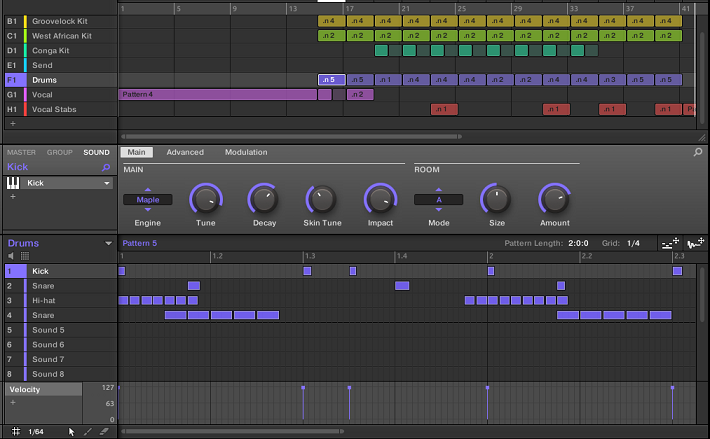There comes a time in life when you have a beat playing in your head or a song/a melody floating in your mind, and you realize that you have never heard that sound or beat before. That is probably because you just created something new – now wouldn’t it be great if you express that sound and share it with people around you? That’s what beat makers/producers do and it is a skill that anyone that has an interest or passion in music can learn – regardless of background, age, musical skill level. Once you are willing to learn and practice, you can become a good producer/beat maker.
For this post, I will focus on the basic elements that make up a beat. Every genre of music has it distinct features – reggae sounds different from hip-hop because of things like difference in rhythm, difference in tempo – but what I am going to focus on is the underlying similarities between different genres of music and how you can use this fundamental to create your own sounds.
Drums: This is the foundation of any beat, before you get too carried away with any other part of the beat, make sure the drums are tight!! There are several ways to approach this segment of the beat – you can use a drum loop (a recorded version of a drum break that is played over and over again) or you can create your own beat pattern. A basic beat pattern has three elements – The Kick (Bass Drum), The Snare and Hi-hats. Below is an example of a basic beat pattern, you can move different things around to create a more complex beat pattern. Be creative – the only rule here is that it sounds tight!!
[image src=”https://toffysdomes.com/wp-content/uploads/2014/10/Drum-Pattern.png” alt=”Alt Text” type=”rounded, circle, thumbnail, none” float=”left, right, none” link=”true” href=”#” title=”Title” target=”blank” info=”tooltip, popover” info_place=”top, right, bottom, left” info_trigger=”hover, click, focus” info_content=”This content will only show up if you have decided to show a popover.” lightbox_thumb=”http://yourdomain.com/path/to/your/image.jpg” lightbox_video=”true” lightbox_caption=”This content will only show up if you use a lightbox”]
Bass: This is instrument that fills the beat – sometimes you may not hear the bass but you can definitely feel it. The best description that I heard is that the bass is the glue between the drums and the other instruments and that’s how I think about the bass. Depending on the type of beat you are making, the bass can be very simple or complex, regardless the is a very crucial part of a beat. Without the bass, the beat can feel empty – if that’s the sound you are going for, then that’s good if not, you will need to include the bass.
Orchestration: This is the part of the beat where you can add your main variation to a beat. It is basically the instruments that you want to have in the beat – electric piano, horns, guitars, synths e.t.c. Depending on the type of beat you are creating, you want to choose instruments to match it. If you are making an R&B track, you might want to use electric pianos, a jazzy beat could have saxophones or trumpet or both. There are no real rules here, the main thing is to have a good melody that matches the bassline and the drums. You can either play the melody out with a midi controller or if you are like me whose instrument-playing ability is limited, you can sample an instrument from another recording and loop it into your track.
Percussion: These are the extra percussive sounds that you can add to your beat to give it that extra ginger!!! Add some Djembes and Congas to give it some West African vibes; add Arabian or Indian drums; cowbells, tambourines, berimbeau (Brazilian) or Ilu (Talking drums). The idea here is that, you are only bound by your imagination – trust your ears and make sure it fits well with your other sounds. You don’t want things to get too cluttered.
Added Tips
Visualization: Before you make a beat, try to visualize the song – how do you want to arrange the different sounds and position each instrument. Look at how instruments are arranged at an Orchestra or on stage at a live show and try to recreate it by position your sounds to mimic what you will like the listener to hear. If you want to make an afrobeat track, watch some Fela performances and see how all band members are arranged on the stage and arrange your instruments similarly (Are the drums in the center? Is the bass guitar on the left? Sax in the middle and percussion on the left. You do not have to do this all the time, but it is helpful to visualize what type of beat you want to make.
Inspiration: Listen to a lot of music. If you want to make Hip-Hop beats, listen to a lot of hiphop and try to listen to the various parts of the beats and how they are arranged. Don’t limit yourself to just one genre of music, inspiration can come from anywhere – listen to as much music as possible and have an open mind.
Be creative: Don’t limit yourself. There might be a certain structure that you will need when you start making beats, but this structure is only needed to as a tool to guide your creativity. Eventually, once you learn how to use these tools properly, then the possibilities are endless and you will soon start having your own signature sound.
Be creative, keep and open mind and trust your ears.

